In order to imbibe the Chaitanya (Divine Consciousness) of the Deity, after completing the pradakshina (circumambulation) of the Deity in the Devalay (Temple) we all take Tirth (Sacred liquid) and Prasad (Holy sacrament). If we were to follow the guidance given in our Shastras (scriptures) and partake the Prasad and the Tirth in a spiritually correct manner, then we will be able to derive maximum benefit from it. Given ahead is the science underlying partaking of Tirth and Prasad while doing Namjap (Chanting the Deity’s Name).
1. Tirth
A. As compared to Prasad, Tirth has greater capacity to imbibe sattvikta (purity) and hence, after partaking of Tirth, it is beneficial to smear it on the eyes, Brahmarandhra, head and neck
Question: After taking Tirth with the right hand, the same hand is touched on the eyes, Brahmarandhra (Seventh centre [chakra] in the spiritual energy system, located on the crown in the subtle body), the head and the neck. This is not done after partaking Prasad. What is the reason behind this ?
Answer : Prasad is associated with the Pruthvi-tattva (Absolute Earth Principle). It has lesser capacity to receive and transmit sattvikta as compared to Tirth, which is associated with Apa-tattva (Absolute Water Principle). Therefore, in order to benefit from the sattvikta, Tirth is smeared on the eyes, Brahmarandhra, head and neck. Repeating these same actions while accepting Prasad does not render much benefit, and hence, these actions are avoided after receiving the Prasad.
Proportion of vibrations
| Vibrations | Principle in the Tirth | Benefits of partaking of Tirth |
|---|---|---|
| Divine Principle | 2 | 1 |
| Anand | 1.25 | 1 |
| Chaitanya | 2.25 | 2 |
| Shakti | 2 | 1 |
-
Tirth is associated with Apa-tattva. Hence, it has a higher proportion of Chaitanya and Shakti (Divine Energy) in it.
-
Upon partaking of Tirth, particles of Chaitanya spread in the blood. Consequently, the body is rejuvenated.
-
Tirth of the Deity has Shakti akin to the sattvikta of five Holy rivers (namely, Ganga, Krushna, Godavari, Tungabhadra & Kaveri).
-
Tirth has higher proportion of Shakti in it when compared with Prasad; because, Tirth is that water with which the Deity is bathed and has thus touched the Deity. However, Prasad is offered to the Deity in the form of Naivedya (Food offered to the Deity as part of ritualistic worship). Therefore, comparatively it has a higher proportion of sattvikta in it.
-
The sagun -nirgun Principle of the Deity comes into the Tirth.
-
Upon partaking of such Tirth, internal purification of the body takes place.
- By taking the Tirth in the palm of the right hand and partaking it, the Deity Principle is emitted and activated in the body. Likewise, it is emitted into the environment in a little proportion.
B. Importance of touching the palm to the eyes, forehead, Brahmarandhra, and neck after taking Tirth
Take the Tîrth on the palm of the right hand and sip it. When it enters the stomach through the mouth, Chaitanya is transmitted to all the body parts below the neck. When the same palm is touched to the external parts of the body, that is, the eyes, forehead (Adnya-chakra, Sixth centre or the Chakra), Brahmarandhra and the neck, Chaitanya in the Tirth affects the external parts too.
2. Prasad
A. Factors on which divinity of the Prasad depends
| Factors | Proportion (%) | Analysis of the factors |
|---|---|---|
| Bhav of the jiva accepting the Prasad | 70 | More the bhav of the jiva accepting the prasad more is the awakening and activation of the Divine Principle in the Prasad due to the bhav-urja (Energy of the spiritual emotion) that is in communion with Divine Principle in the sagun form |
| Divinity in the actual idol | 20 | The Deity’s waves necessary for the action are emitted from the actual form of the Deity through the idol, proportionate to the divinity in it. These waves are then transmitted to the prasad with the help of the divinity in the idol. The prasad then gets charged with divinity. The prasad obtained from Deities who are always in an awakened state (for example, Siddhivinayak, Mahankayeshwar) retain divinity for a longer period. Conversely, divinity in the prasad of inferior Deities is less in proportion. |
| Substance in the prasad | 10 | It is necessary to use only specific substances for prasad, those which are able to absorb waves of that perticular Diety. This helps retain divinity in the prasad longer. Similarly, if the substances used are sattvik, divinity lasts longer. |
| Total | 100 |
Using the right hand while accepting the Prasad amounts to activating the kriya-shakti (Energy of action), and with its help, receiving the Principles in the form of blessings of Deities
B. What is the reason for accepting the Prasad only with the right hand ?
Prasad consists of Principles associated with the respective Deities. Accepting Prasad with the right hand amounts to activating the kriya-shakti (Energy of action), and with its help, receiving the Principles in the form of blessings of the Deity. Accepting the Prasad with the right hand retains its sattvikta; whereas, accepting it with the left hand results in a 10% reduction in the Deity’s Principle due to the lack of activation of kriya-shakti. Also, by receiving the Prasad with the right hand, a person’s Surya-nadi is activated and his bhav is awakened.
Picture based on subtle-knowledge showing benefits ofreceiving Prasad with the right palm
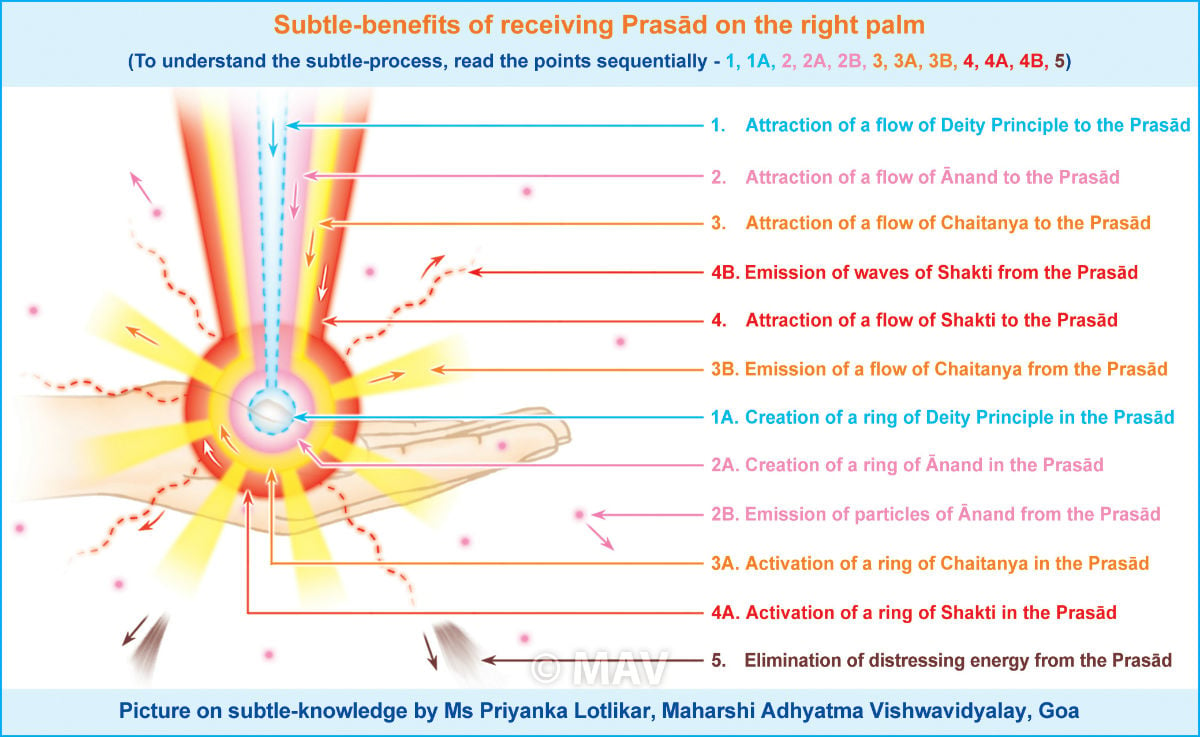
Vibrations obtained upon receiving Prasad with the right palm.
| Vibration in the Prasad | Vibration obtained by the person
upon receiving Prasad with right palm |
|
|---|---|---|
| Divine Principle | 1 | |
| Anand | 2 | 1.25 |
| Chaitanya | 2 | 1 |
| Shakti | 2 | 2 |
| Black energy | – | Removal of black energy |
C. Humbly bowing while accepting the Prasad increases the sattvikta within the body
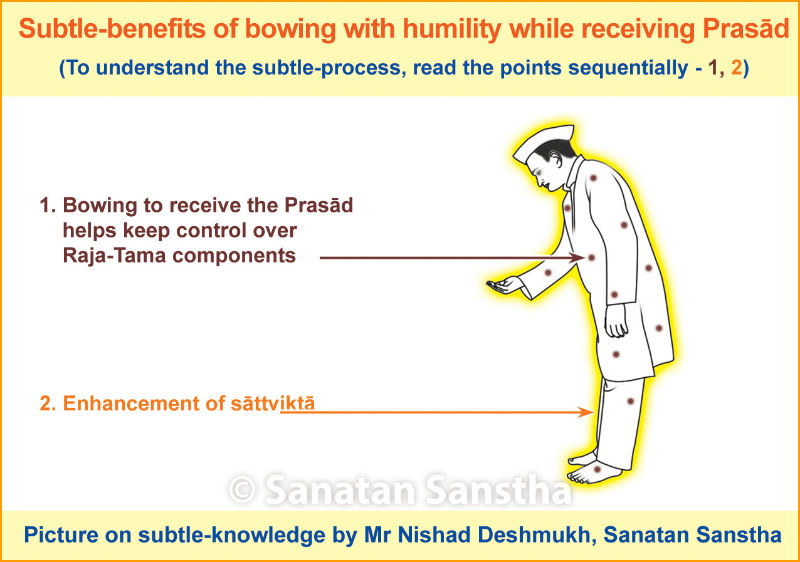
Bowing while accepting the Prasad forms a specific posture of the body that restricts the Raja-Tama particles and increases the sattvikta in the body. Due to the specific posture,the individual accepting the Prasad gets the added benefit of 2 to 3 percent Chaitanya from the Prasad.
D. Chanting while sitting in front of the Deity
After completing pradakshina (circumambulation) and partaking Prasad, we should sit in front of the Deity and chant the Name of the Deity for atleast 15 minutes or a minimum of 3 malas (rosary). This benefits the individual in the following manner.
-
Waves emitted by the Deity are activated and the individual benefitsfrom them. Since the individual gets the Deity’s Chaitanya in the Devalay, it is able to obtain the grace of the Deity much faster.
-
Since the environment in a Devalay is sattvik, chanting in the Devalay gets performed in a better manner than at home. For this reason, Jains carry their Japamala (rosary) to a Devalay and chant there.
E. What is the science underlying partaking of the Prasad while being seated?
Sitting inside a Devalay denotes detaching the self from activity oriented karma (an act that gives rise to destiny) and performing karma associated with indirect activity. Raja-Tama components required for activity oriented karma in an individual are continuously in an awakened state. Prasad when partaken while standing, has the energy of the activity-oriented karma. This can reduce the sattvikta and create a possibility of increase in Raja-Tama. On the other hand, in karma associated with indirect activity, Raja-Tama component in an individual is dominated by sattvikta and sattvikta is in an awakened state. Thus, while performing karma associated with indirect activity, loss of sattvikta is less.
F. Science underlying the necessity of partaking Prasad immediately
In Kaliyug (Current Era of Strife), since the predominance of Raja-Tama component is high, even a substance like Prasad charged with Divine radiance is not spared from the attacks of Raja-Tama. Since bhav of the individual in Kaliyug is not much, sattvikta in the Prasad does not last long. To benefit from the sattvikta in the Prasad, it should be partaken immediately.
G. There is less likelihood of negative energy attacks on the Prasad because of the sattvikta of the Devalay
As compared to other places, sattvikta in a Devalay is always more. Therefore, if Prasad is partaken in the Devalay itself, there is less likelihood of attacks by negative energies on it. On the other hand, if the Prasad is partaken elsewhere, outside the Devalay, negative energies are likely to take advantage of the presence of Raja-Tama, and attack the Prasad. This can lead to the creation of a negative energy centre in the individual’s body. Therefore, whenever possible we should partake Prasad in the Devalay itself.
H. If you want to carry the Prasad home, then wrap it in a clean cloth, to avoid attacks by negative energies
Carrying the Prasad home depends upon the bhav of the individual. It is always correct to carry Prasad for people who are not able to visit the Devalay. But then, it should be first wrapped in a clean cloth and then carried. This reduces the attacks of negative energies by 10%.
Reference : Sanatan’s Holy Text, ‘How should one have darshan in a temple?’

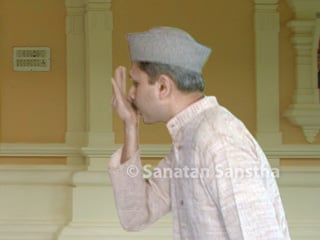
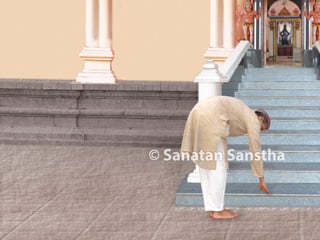 The correct method of having darshan in a Devalay (Temple)
The correct method of having darshan in a Devalay (Temple)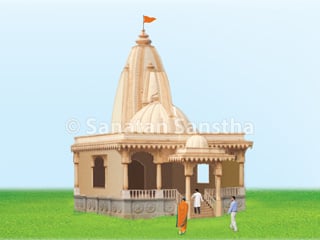 Importance of having darshan in a Devalay (Temple)
Importance of having darshan in a Devalay (Temple) Performing Pradakshina (Circumambulation) of a Deity
Performing Pradakshina (Circumambulation) of a Deity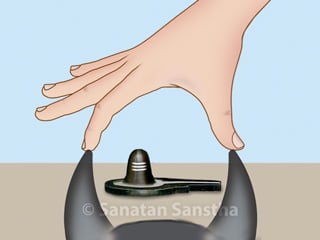 Importance of taking darshan of Nandi before darshan of the pindi in Deity Shiva’s Devalay
Importance of taking darshan of Nandi before darshan of the pindi in Deity Shiva’s Devalay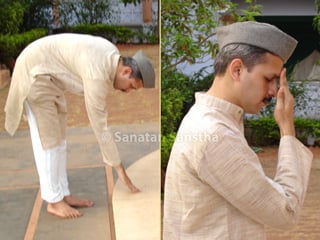 Visiting a Hindu temple - How to take benefits spiritually
Visiting a Hindu temple - How to take benefits spiritually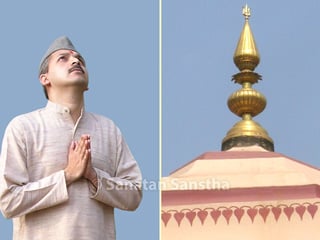 Taking darshan of the kalash (Dome) of the Devalay
Taking darshan of the kalash (Dome) of the Devalay